Archive for September, 2016
Genealogy Eyewear
 Do you have trouble seeing a computer screen? I do.
Do you have trouble seeing a computer screen? I do.
I spend many hours a week in front of the computer in my genealogy pursuit. My eyesight is not great. For several years I have worn either bifocal contact lenses or progressive lens glasses. The sweet spot in the lenses for the middle distance needed for computer viewing is quite small. Increasingly, I have found myself with my head tilted up and back as I worked. Only from there could I focus on the screen. At the end of a session, my neck and back hurt.
It finally dawned on me this summer that optometrists have devised a solution for this problem. Computer glasses! My husband/tech adviser has had them for years, but I never before realized that I needed them, too. He urged me to get some.
When I went in for my annual vision checkup this month, I asked about getting a pair. Not only did my doctor think it a good idea, he also told me that I had a choice of two different types.
He asked whether I worked in a business office where I would sometimes need to walk around to meetings, etc. Or did I work in a Just-Me-And-The-Computer setting? The answer to this question would influence how much of the lens on the glasses could be devoted to the computer-viewing distance.
Of course I work in my home office, so I do not need glasses suitable for a large work setting. Based on that information my optometrist wrote up a prescription. Soon I was off to the frame showroom to select the style for my new eyewear.
I picked them up yesterday. What an improvement! I am hoping neck strain will be a thing of the past for me. I just need to remember the technician’s parting instructions, “Do not use these for driving!” I got it—computer only.
52 Ancestors in 52 Weeks no. 33—John Carter (ca. 1790-1841)
 John Carter, my 3rd great-grandfather, came from a prolific Carter clan. We do not really know the identities of his parents, but his father may have been named Caleb Carter.
John Carter, my 3rd great-grandfather, came from a prolific Carter clan. We do not really know the identities of his parents, but his father may have been named Caleb Carter.
John hailed from Greene County, Tennessee, one of numerous Carters in the county. Various sources report his birth date as 19 July in 1783, 1784, 1790, or 1793. His daughter Jane’s family Bible provides the 1790 date.
According to his widow’s claim for bounty land, John was drafted for the War of 1812 in February 1813 for the term of three months. He continued in actual service for six months. Her claim states he served as a private in the company of Captain Hyle under the command of Colonel Gibbs. At the time, his residence was Greenville, Tennessee.
After the war, John wanted to marry a neighbor girl, Polly Templeton. On 9 February, 1815 in Greene County, he executed an affidavit saying in part: on the 7 day of this instant he obtained a lacence (sic) of clerk of sd county to marry him the said Carter to Polly Templeton and further states that he lost them.” John signed the document with a mark, indicating that he could not write.
John did marry Polly that same day at Greenville, Tennessee. The first of their nine children arrived later that year:
- Susan (1815-1884)
- Shelton (1816-1890)
- Nancy (1818-1901)
- Bailey (abt. 1820-1847)
- Thena (1823-1855)
- Janete or Jane (1824-1907)
- Joseph (1827-1903)
- Elizabeth (1829-1848)
- Catharine (1832-1885)
After Susan’s birth, the family moved on to Wayne County, Kentucky. They lived in that state a number of years. When some lands opened up for settlement in Illinois, the Carters pulled up stakes and moved again. They became “Pioneers of 1830” in the about-to-be-formed Coles County, arriving on April 10 of that year. They settled east of the village of Ashmore.
Initially, John worked sometimes as a blacksmith in addition to farming. When other blacksmiths moved into the area, he gave up that trade and focused on his farm.
By 1841, John had become ill and knew he was dying. He asked that his funeral service be conducted on the Sabbath after his death. He requested the Scripture from the second Epistle of Paul to Timothy: 6-8. He said, “For I am now ready to be offered, and the time of my departure is at hand. I have fought a good fight. I have finished my course. I have kept the Faith. Henceforth there is laid up for me a crown of righteousness which the Lord, the righteous judge, shall give me at that day, and not to me only but unto all those also that love his appearing.” He instructed his children to “do the best you can and try and meet me in heaven.”
John passed away on July 19, 1841. He was buried in the Ashmore Cemetery, Coles County, Illinois.
Differentiating Emily and Eliza
 My ancestor Daniel Sherman (abt. 1800-bef. 1870), a blacksmith who lived in central Kentucky, had several children. Among his daughters enumerated on the 1850 census we find two girls named Emily E. and Eliza J.
My ancestor Daniel Sherman (abt. 1800-bef. 1870), a blacksmith who lived in central Kentucky, had several children. Among his daughters enumerated on the 1850 census we find two girls named Emily E. and Eliza J.
Later that decade, we find Daniel giving consent for his daughters to marry. This time, their names appear as Elizabeth (E. E.) and Louisa Jane. Same girls? If so, how do we reconcile these differences in their names?
I do not feel I have yet sorted this out, but so far I have assembled this evidence for the daughters:
Emily E. Elizabeth (E. E.) Eliza J. Louisa Jane
b. abt. 1836 (1850 census) b. abt. 1836 (marriage) b. abt. 1838 (1850 census)
b. Kentucky (1850 census) b. Scioto Co., OH (marriage) b. Ohio (1850 census)
b. 1836 KY (1880 census)
m. John H. Glover (marriage) b. KY (1860-70 census) m. Stephen Dykes (marriage)
John H. Glover has not been found on the 1860 or 1870 census records. His wife Elizabeth, born in Kentucky, is named on the 1880 census, the last record of her.
Stephen Dyke appears on the census in 1860 and 1870 with his wife Eliza and Eliza Jane. By 1880 he was a widower. His wife’s birthplace was reported as Kentucky in both instances.
I find it so tempting to conclude that the Emily E. of the 1850 census is the E. E. or Elizabeth who married John Glover. It’s also tantalizingly easy to assume that Eliza J. and Louisa Jane are the same girl because the names are phonetically close. Yet the evidence does not quite match up. Was one of the daughters born in Ohio? If so, which one? Why would the marriage record and permission slip of one daughter clearly say her name was Louisa Jane if her name was really Eliza, as it always appears on the census records? Did Daniel Sherman have more than two daughter born during this time frame? If so, where were they when the 1850 census was taken?
As is always the case on these family puzzles, I need some more evidence.
52 Ancestors in 52 Weeks, no. 32—Ann Kirkham (1782?-1869)
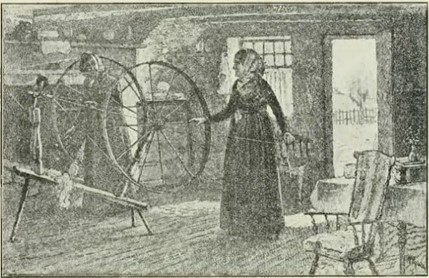 Ann Kirkham, my 3rd great-grandmother, pursued the hard life of a pioneer but lived to a ripe, old age nevertheless. She must have been made of tough stuff.
Ann Kirkham, my 3rd great-grandmother, pursued the hard life of a pioneer but lived to a ripe, old age nevertheless. She must have been made of tough stuff.
Her actual birth place, date, and year have not been proven as far as I know. Records agree that she was born during the month of August, but the date varies as 1782 or 1783. Some sources say she was born in Kentucky; others report her birthplace as Pennsylvania.
By 1806 she lived in Nelson County, Kentucky when she married Thomas Reed. They wed on November 24 and then relocated to live near Thomas’ family in Spencer County. There the couple had five children: Robertson Mitchell (1808), Eliza (1810), Jane (1817), Caleb (1818), and William (1822). Given the long spaces between Eliza and Jane, and again between Caleb and William, perhaps there were other children who died young.
In 1829, Thomas Reed sold his Kentucky holdings. He and other family members struck out for newly opened lands in Indiana and Illinois. Thomas and Ann chose the latter, settling in Coles County, Illinois after the new year in 1830. They took along as much of their household goods as they could, including Ann’s spinning wheel.
Early Coles County families faced a primitive life. They built cabins of unhewn logs with puncheon floors. Chimneys were made of sticks and clay. Perhaps Ann could enjoy some time quilting or sewing with nearby women-folk while Thomas and the other men constructed the first homes.
The couple built a financially successful life in Illinois, but personal tragedy struck periodically. Ann made the trip to the fresh graves of family members many times over the years:
- In 1836, her son-in-law John Mitchell McAlister (Eliza’s husband), died,
- In 1845 her son William passed away,
- In 1852 her husband Thomas died, leaving her a widow,
- In 1853 her daughter-in-law Nancy McAlister Reed, who was Robertson’s wife, died,
- In 1854, her grandson and Caleb’s third son, Thomas B. Reed, died in infancy,
- In 1855, her granddaughter and Caleb’s oldest daughter, Mary C. Reed, died at the age of eight,
- In 1856, her granddaughter Susan McAlister Galbreath (Eliza’s daughter) died from complications of childbirth,
- In 1864, another grandson, Caleb’s son James N. Reed, died in infancy.
During her latter years, after Thomas’ death, Ann made her home with her son Caleb and his family. When she reached her mid-80’s her life was drawing to a close. Ann passed away on 3 February 1869. She was buried beside Thomas in the Reed-McAlister Cemetery in Coles County, Illinois.
We’re Going to Germany
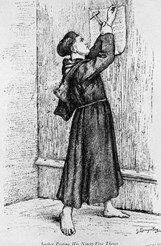 This month we began some serious preparation for an upcoming trip to Germany. Next year will be the 500th anniversary of the Protestant Reformation, and my church choir (http://www.blc-denver2.org/ministries/music/adult-choirs/chancel-choir/) has decided to mark the occasion by taking a tour. We will travel through the area associated with Martin Luther, the seminal theologian whose questioning of Roman Catholic dogma led to the breach of Christian denominations. During this tour, we plan to visit the historic sites associated with Luther and to perform in cities including Berlin, Leipzig, and Prague.
This month we began some serious preparation for an upcoming trip to Germany. Next year will be the 500th anniversary of the Protestant Reformation, and my church choir (http://www.blc-denver2.org/ministries/music/adult-choirs/chancel-choir/) has decided to mark the occasion by taking a tour. We will travel through the area associated with Martin Luther, the seminal theologian whose questioning of Roman Catholic dogma led to the breach of Christian denominations. During this tour, we plan to visit the historic sites associated with Luther and to perform in cities including Berlin, Leipzig, and Prague.
Because my husband/tech advisor has much German and Dutch heritage while I might have a little of the same, we plan to tack a few days onto this trip to explore the areas of our roots. So far we have done these things to get ready for this trip:
- My husband/tech advisor continues to document his German and Dutch lines (Dols, Flottemesch, Kirchner, Walz, Wohrman) as best as he can to identify villages we should visit.
- We booked a flight to Hamburg on Icelandair, and from there we will rent a car and drive through the areas of our origins.
- We paid our first installment for the choir tour.
- At my local library’s used book sale last weekend, I picked up a book on conversational German and a German/English dictionary.
Now I am raring to go. Next spring seems a long way away, but anticipation is half the fun. While we wait we have more time to work on our German genealogy and to study up on some key German phrases.
Tschüss!
52 Ancestors in 52 Weeks, no. 31—Thomas Reed (1783-1852)
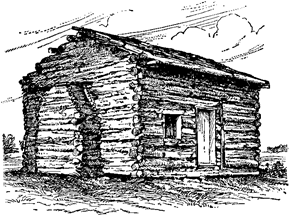 Thomas Reed was my paternal 3rd great-grandfather. He was born in one place, raised in another, and lived his adult life in yet a third locality.
Thomas Reed was my paternal 3rd great-grandfather. He was born in one place, raised in another, and lived his adult life in yet a third locality.
According to family records, Thomas arrived perhaps on the 18th of December, 1783 in Fayette County, Pennsylvania. His father was Caleb Reed, and his mother may have been Rebecca Carr. Thomas’ actual birthdate remains uncertain because his cemetery marker in the Reed family cemetery provides the calculation for a different date. It states that he died on 21 December 1852 at the age of 70 years, 11 months, and 23 days. This information means he would have been born 29 Jan 1781. So far I have no explanation for the difference in proposed birth years, nor do I know which, 1783 or 1781, is more likely correct.
In either case, Thomas came into the world during the close of the Revolutionary War era. The family lived on the fluid border between Pennsylvania and then-Virginia, now West Virginia. His uncle Joshua Reed served in the Virginia militia during that conflict. As with all American families at the time, the Reeds were affected by the war.
At some point, the Reeds relocated to Kentucky, near Louisville. Thomas married Ann Kirkham in Nelson County, Kentucky on 24 November 1806. The couple settled onto a place in Spencer County and had a family of five children:
- Robertson Mitchell Reed (1808-1871)
- Eliza Reed (1810-1886)
- Jane Reed (1817-1899)
- Joseph Caleb Reed (1818-1903), my great-great grandfather
- William Reed (1822-1845)
In 1829, Thomas and Ann made the decision to move on to new lands opening up for settlement in Illinois. They left Kentucky on December 1, their son Caleb’s 11th birthday, and headed for southeastern Illinois, near the Indiana border. With a 6-horse team, the journey took nearly a month. They stopped in Edgar County, Illinois for a few days, and they liked the Grandview area very much. However, the “milk sickness” malady was rumored to be common there, so they went further west into Coles County. They settled about a mile and a half northeast of the village of Ashmore where Thomas entered a tract of land. Among his Coles County neighbors was Thomas Lincoln, father of the future President.
Once settled in, Thomas Reed went walking one day with his neighbor, Daniel McAlister. They stopped at a particularly beautiful spot and decided it would make a lovely place for a burial ground. They set it aside as the Reed-McAlister Cemetery. Both would be buried there someday.
In 1832, Thomas’ father Caleb, who had also left Kentucky and moved on to Indiana, passed away. Thomas received his timepiece.
Thomas and Ann worked to build up their farm and raise their family in Illinois. Thomas was known as a quiet and industrious man, and at one time he farmed nearly a thousand acres. It was about half prairie and half woodland with streams of water flowing through most of it.
Politically, Thomas was a strong Whig, but he never sought public office. Farming took all his time.
Thomas passed away on 21 Dec 1852 and was buried in the family cemetery in Coles, County, Illinois. He died intestate, and his farm was divided into four parts. Each surviving child received a share, but the daughters sold theirs to the sons, with Robertson, the eldest, receiving a larger share. Thomas’ daughter Eliza’s husband James Walton served as Personal Representative.
Thomas Reed became the patriarch of a large Reed clan in Coles County, Illinois. Descendants live and farm there to the present day. Thomas chose a good place to settle down.
In Memory of Mary Ann
 For the fifth time this year, we have lost a family member. It has been a bad year.
For the fifth time this year, we have lost a family member. It has been a bad year.
Mary Ann was my daughter-in-law’s beloved grandmother, 83 years old. She lived miles away in Oklahoma, but she stayed closely in touch with her grandchildren. They spoke on the phone often, and the younger generation regularly received care packages from their grandma. They visited back and forth, too.
Mary Ann was one of the friendliest and most generous people I have known. She paid for preschool for her great-grandchildren as long as they attended a church-affiliated one.
A week ago, she missed her usual Sunday morning church service. Her fellow parishioners became concerned and sent someone to check. Of course they soon found that she would not be attending church with them anymore.
Today I will attend a memorial service for her here in Colorado, her long-time home before she retired in Oklahoma. It’s too bad she cannot be there in person to greet all of us. She would have loved a large family gathering. She and Charlie probably will watch from above.
Mary Ann, fondly remembered, sadly missed.
52 Ancestors in 52 Weeks, nos. 29 & 30—Matti Lampinen (b. 1835) and Anna Miettinen (b.1832)
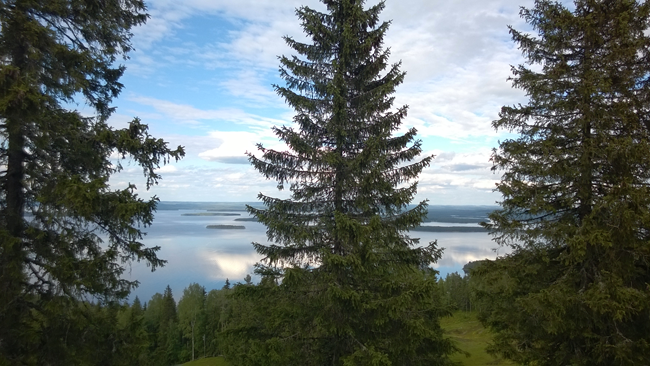
Karelia
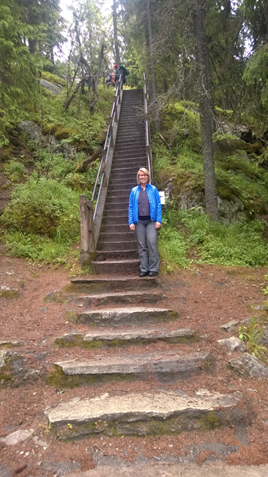 The Lampinen family lived in the area of the present-day Koli National Park in eastern Finland. The park lies west of Lake Pielinen, the fourth-largest in Finland, in the sub-region known as Karelia. Here the gorgeous forest landscape near the lake includes rock outcroppings intermingled with lush groves of spruce, birch, and other trees. The undergrowth is rich in mushrooms and berries. Wolverine, lynx, bear, and beaver abound.
The Lampinen family lived in the area of the present-day Koli National Park in eastern Finland. The park lies west of Lake Pielinen, the fourth-largest in Finland, in the sub-region known as Karelia. Here the gorgeous forest landscape near the lake includes rock outcroppings intermingled with lush groves of spruce, birch, and other trees. The undergrowth is rich in mushrooms and berries. Wolverine, lynx, bear, and beaver abound.
People have lived in the Koli area since before Christianity. It had been a center of pre-Christian religion. The highest point above the lake is still known as the Temple of Silence. The cave formations in the nearby rocks were thought to house wizards and witches.
The Karelians consider themselves the true Finns, uncorrupted by Swedish intermarriage and Germanic influence. Unlike many other Finns, they are lively and talkative. Historically, they ate a distinctive diet marked with local fish and game, often made into pasties.
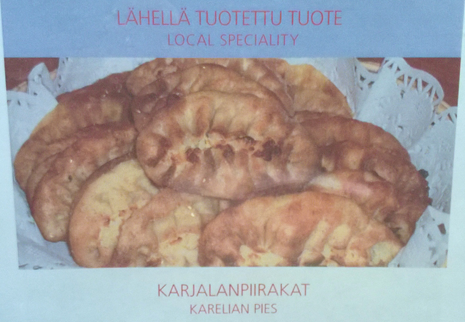
Karelia, especially the Koli area, became a vacation destination for hikers and skiers in the 19th century. Others, including Finland’s great composer Jean Sibelius, came to enjoy the local folklore and the traditional culture. By the time these visitors discovered Koli, the Lampinen family had lived there for a long time.
In the 1830’s they ived in the tiny Karelian village of Nunnanlaks on the western shore of Lake Pielinen. There Valborg Johansdotter Ruottin (1808-after 1860) gave birth to her son Matti Lampinen on 27 September 1835.
She and her husband Henric Mårtensson Lambin (1806-1837) had him baptized in the Juuka parish on 25 October 1835. At this time, spelling and naming patterns had not become standardized, so we see the family name in the records in several iterations, including Lambin, Lampin, Lambinen, and Lampinen. Karelians were early adopters of surnames because they moved around a lot.
Little Matti joined an older brother, Henric, who had been born on 8 August 1832 in the same village. They probably lived in a log house decorated with carvings, but those houses no longer remain. Today Nunnanlaks is known for its soapstone mine.
The boys were born into an ancient swidden, or slash-and-burn culture. Crofters like their father lived by cultivating clearings in the forest. They felled and burned broad-leaf trees, especially birch, in 10-to-30-year intervals. This created a patchwork landscape of varied woodland habitat around settlements.
In the second year, crofters planted turnips, sowed by spitting the seeds. They stored these and other root crops like carrots and rutabaga in cellars dug in the ground.
The third year, they could plant grains such as oats, flax, buckwheat, and rye. They built traditional pole fences to protect these crop fields from livestock. In the fall, they harvested the crops by hand, with a sickle, and then threshed them in a barn.
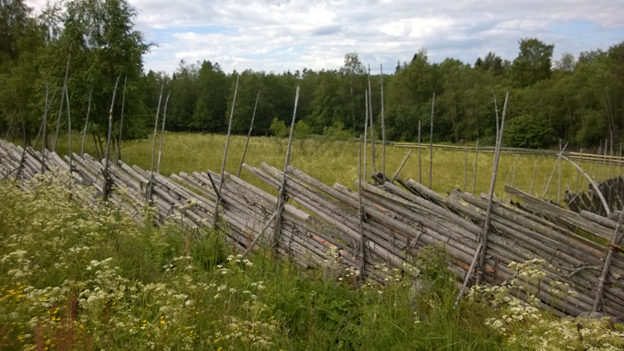 A traditional Finnish fence
A traditional Finnish fence
Once the soil became depleted, they began the swidden cycle again in a new location. As young trees began to grow back, they grazed livestock in the sparse, well-lit forest. They often acquired a pig around midsummer to fatten up for Christmas.
The little Lampinen family did not stay long at Nunnanlaks. By early 1837, when Matti was just over a year old, they had moved on to an inland village, Kuhnusta. That year, the elder Henric contracted typhoid fever and died on 10 February 1837 at the age of thirty. It is unlikely that Matti would have had any memories of his father.
His mother remarried the next year. Valborg Ruottin and Christer Mårtensson Karjalain were wed in Juuka parish on 1 September 1838. Their son Eric, Matti’s half-brother, was born on 29 April 1839 at Nunnanlaks. He was followed by a half-sister named Christina on 24 September 1841.
By 1842, this family, too, had located in Kuhnusta. There, tragedy struck again, and on 2 June 1842 Christer Karjalain died at age 31 from a heart attack. Seven-year-old Matti was fatherless for the second time.
It seems Valborg waited several years to marry a third time. When Matti and Henric were 14 and 17, their mother and Anders Rompanen married. Again in the Juuka parish, the wedding occurred on 14 April 1850. During the following decade, Valborg and Anders lived sometimes at Kuhnusta and sometimes at Nunnanlaks.
Also during the 1850’s Matti courted a young woman from the neighboring village of Halivaara. Anna Miettinen was three years older than Matti. Her parents were Henric Henricson Miettinen (c.1804-1836) of Halivaara and Anna Andersdotter Toivain (1802-after1858) of Kajo.
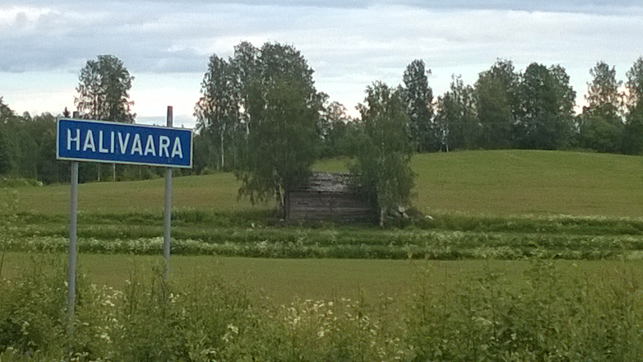
Anna Miettinen’s parents had married in Juuka parish on 27 December 1819, and they had seven children, all born at Halivaara:
- Carin, born 30 June 1821,
- Henric, born 3 August 1823,
- Christina, born 9 November 1827,
- Margret, born 17 September 1829,
- Johan, born 17 February 1830,
- Anna, born 5 February 1832,
- Brita, born 7 August 1835.
Like Matti, Anna lost her father at an early age. Henric Miettinen died of a fever at age 32 at Halivaara on 22 October 1836, when Anna was four years old. No more is known of Anna’s mother Anna Toivain. She was still living at age 55 when she attended a kinkeri or catechism meeting in Juuka parish in 1857.
Matti Lampinen and Anna Miettinen were married in Juuka parish on 7 December 1856. As his father had, Matti worked as a cottager, or tenant farmer.
 Forest near Nunnanlaks and Kuhnusta
Forest near Nunnanlaks and Kuhnusta
They lived sometimes at Nunnanlaks and sometimes at Kuhnusta, and they had the typically large Finnish family of twelve children:
- Henric, born at Nunnanlaks on 14 July 1857,
- Anna Valborg, born at Kuhnusta on 2 May 1859,
- Eva Stina, born at Kuhnusta on 26 March 1861,
- Hendrika, born at Nunnanlaks on 27 November 1862,
- Matts, born at Nunnanlaks on 9 May 1864,
- Alexander, born at Nunnanlaks on 1 April 1866,
- Adam, born at Nunnanlaks on 1 April 1868,
- Alexis, born at Nunnanlaks on 2 August 1868,
- Mathias, born at Nunnanlaks on 7 December 1870,
- Lovisa, born at Nunnanlaks on 11 March 1873,
- Anders, born at Nunnanlaks on 6 December 1876,
- Ada Alina, born at Nunnanlaks on 25 September 1879.
We do not know how long Matti and Anna lived because the available records end in 1880, the year after Ada Alina was born. Presumably, they lived out their lives in Juuka parish and were buried there.
 Juuka church
Juuka church
During their lifetime, the Koli area began to attract big names in Finnish art. Painters like Eero Järnefelt and composers like Jean Sibelius returned year after year for inspiration. Järnefelt painted the internationally-known An Autumn Scene on Lake Pielisjärvi in 1899, and Sibelius composed his fourth symphony (“Koli”) in 1909 after a trip there. The Koli National Park was eventually founded in 1991. Today, the entire area where Matti and Anna Lampinen lived is a beautiful park enjoyed by all the Finns.
Floundering in Indiana
 My Sherman family lived in Indiana during the 1860’s, mostly in Johnson County. I have a little information about them at that time but not enough. Big events occurred in the family during that decade, events for which I have no proof or documentation:
My Sherman family lived in Indiana during the 1860’s, mostly in Johnson County. I have a little information about them at that time but not enough. Big events occurred in the family during that decade, events for which I have no proof or documentation:
- My ancestor Thomas Sherman (1841-1912) is said to have married a German girl named Katherine sometime during the Civil War. They had a daughter, Anna Petronellia, born 1 April 1865 near Indianapolis. The wife died shortly thereafter. I have found no proof of this marriage in Indiana civil or church records. I have found no grave for Katherine. Her reported maiden name, Stillenbaugh, does not appear in the modern-day German phone book, so I suspect this name has been corrupted by the family through the years.
- Thomas and several family members had relocated to Indiana from Kentucky in the early 1860’s. His father Daniel sold land in Madison County, Kentucky in 1863. Daniel disappeared from the record after that. I have not found a grave or any other information about him in Indiana or elsewhere after the land sale. His wife Rebecca was a widow by 1870.
- Some of Thomas’ descendants claim he served the Union during the Civil War, enlisting at Louisville, KY. I have not found a service record for him from Kentucky or Indiana.
Over the years I have searched every Indiana record I can find in an effort to learn about Thomas’ first marriage and his Civil War service. I have looked for information on the death of Daniel Sherman which must have occurred during the same time period. Nothing.
I have heavily researched most of the children in the family in an effort to shed light on the lives of Thomas and Daniel. I have a couple of people to go—sisters, Polly, Emily, and Elizabeth. As we all know, searching women’s lives presents quite a challenge. Yet this is the only avenue I have left in my effort to uncover information in the Sherman men in my direct line during the 1860’s.